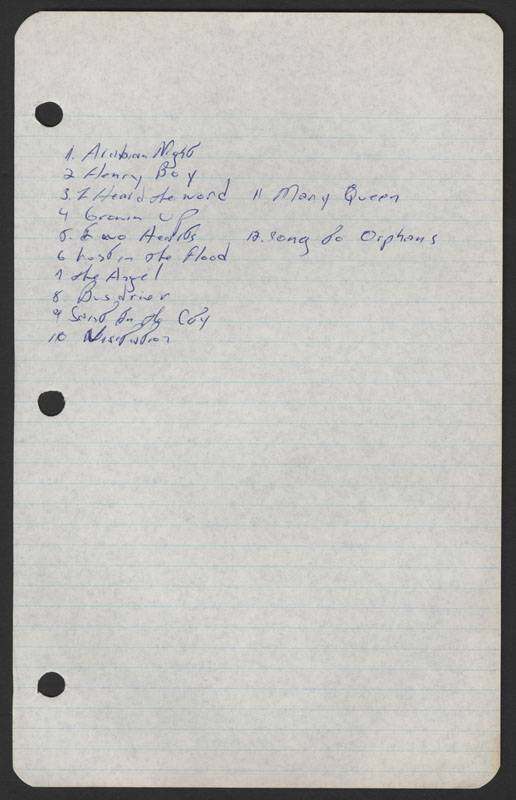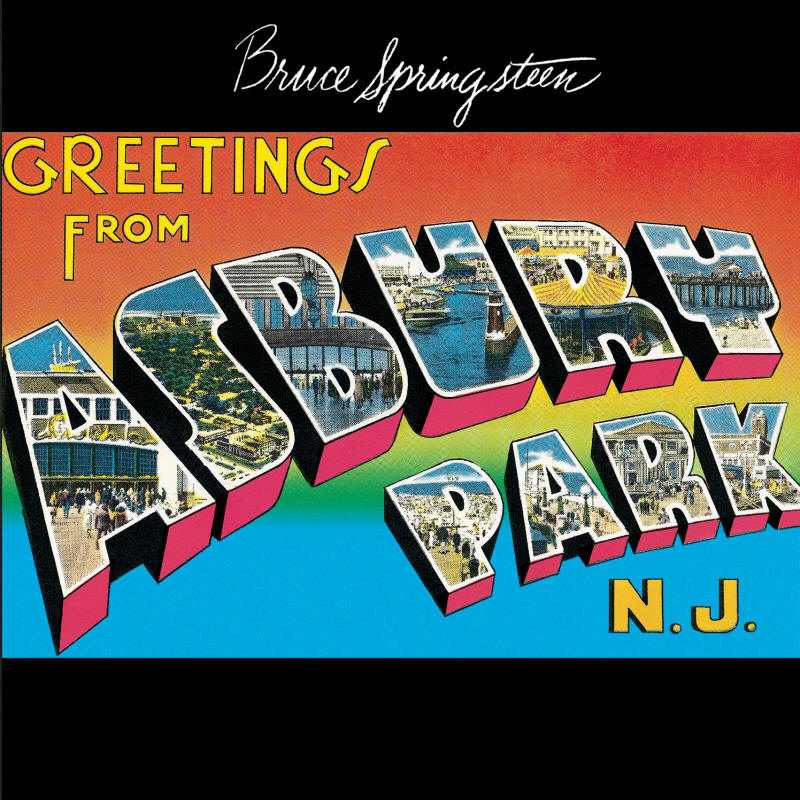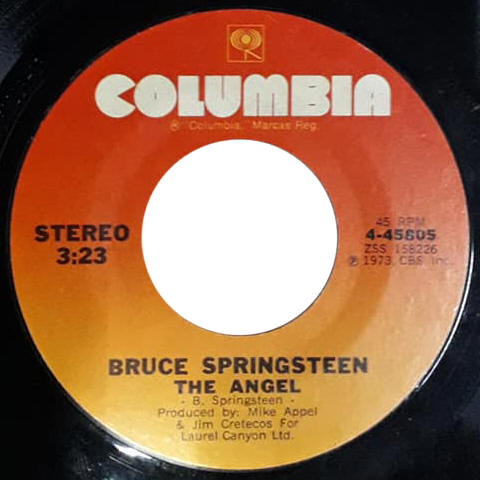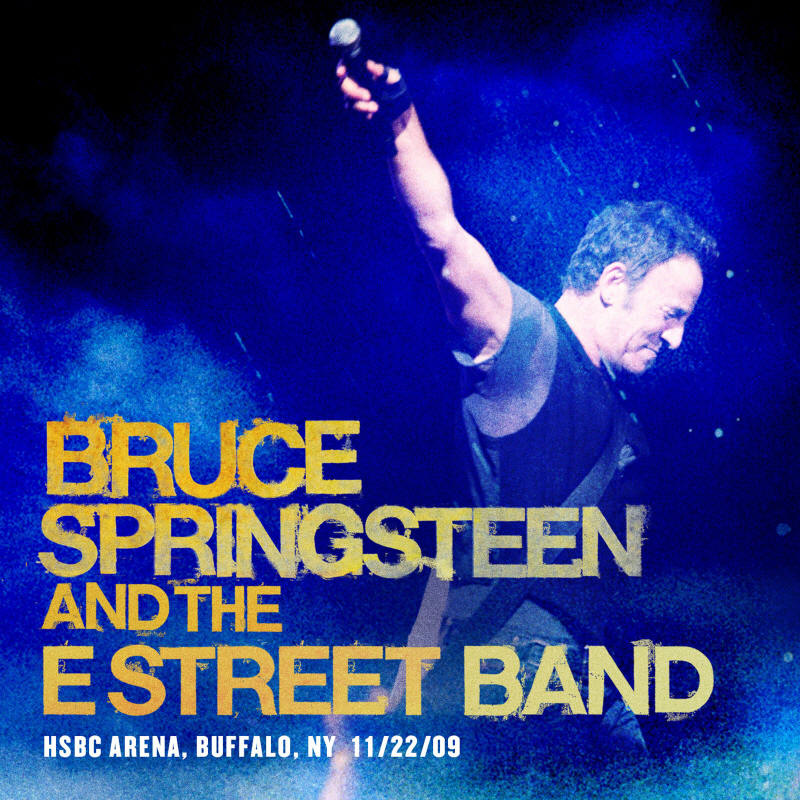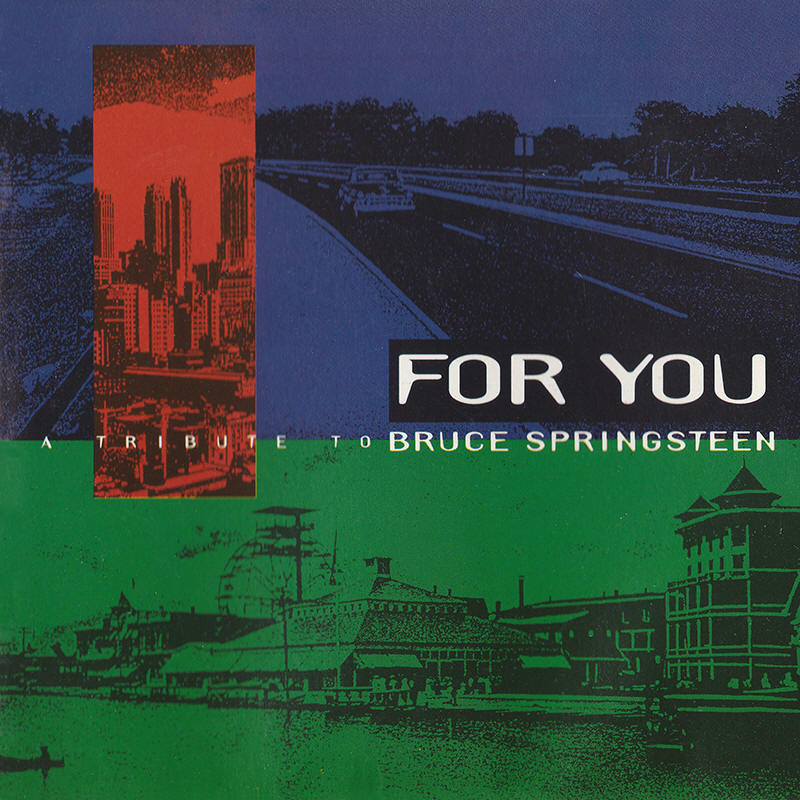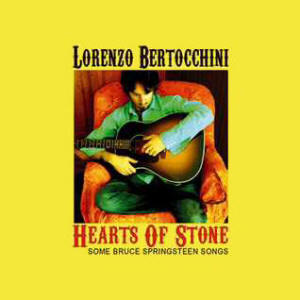THE ANGEL 
Album version
The angel rides with hunch-back children
Poison oozing from his engine
Wieldin' love as a lethal weapon
On his way to hubcap heaven
Baseball cards poked in his spokes
His boots in oil he's patiently soaked
The roadside attendant nervously jokes
As the angel's tires stroke his precious pavement
Well, the interstate's choked with nomadic hordes
In Volkswagen vans with full running boards dragging great anchors
Followin' dead-end signs into the sores
The angel rides by humpin' his hunk metal whore
Madison Avenue's claim to fame
In a trainer bra with eyes like rain
She rubs against the weather-beaten frame
And asks the angel for his name
Off in the distance the marble dome
Reflects across the flatlands with a naked feel off into parts unknown
The woman strokes his polished chrome
And lies beside the angel's bones
Info
THE ANGEL is a song written by Bruce Springsteen and released on his 1973 album Greetings From Asbury Park, N.J. The above lyrics are for Bruce Springsteen's album version of THE ANGEL as released in 1973.
Writing and Recording
THE ANGEL was recorded during the Greetings From Asbury Park, N.J. album recording sessions at 914 Sound Studios in Blauvelt, NY. The track, as well as the whole album, was produced by Mike Appel and Jimmy Cretecos. Bruce Springsteen plays piano and sings vocals on the officially released album version of the song, and is backed by Richard Davis on upright bass. The basic track was recorded by Springsteen and then Richard Davis' upright bass track was overdubbed later in the Greetings From Asbury Park, N.J. recording sessions. The above lyrics transcribed from the album version of THE ANGEL.
According to Sony's logs of Bruce Springsteen's studio sessions, THE ANGEL was cut on 26 Jun 1972, 27 Jun 1972, 29 Jun 1972, and 26 Oct 1972 at 914 Sound Studios. It is not clear at which of these four recording sessions the album version of THE ANGEL was cut, or if it was cut in another session.
Bruce Springsteen performed THE ANGEL during an audition for Mike Appel and Jim Cretecos on 14 Feb 1972 at Appel's office at Pocketful Of Tunes. Bob Spitz was also present and he recorded the performance on a reel-to-reel tape recorder. A solo demo of THE ANGEL was performed and recorded during Springsteen's first formal studio audition for CBS Records on 03 May 1972. It features Springsteen solo on vocals and acoustic guitar. See the 03 May 1972 demo version and the "1971-1972 Auditions" section below for more details.
In his 2012 book E Street Shuffle: The Glory Days of Bruce Springsteen & the E Street Band, Clinton Heylin mentioned that after THE ANGEL was recorded in June 1972 at 914 Sound Studios, "it featured on all the various provisional track-listings for Greetings."
THE ANGEL appears on a Springsteen handwritten song list that was put up for auction in December 2013 on GottaHaveRockAndRoll.com. This is most probably a list of songs that Springsteen was considering taking into the studio at the very early stages of the Greetings From Asbury Park, N.J. recording sessions (July 1972).
1972 handwritten song list
The line "The interstate's choked with nomadic hordes" may have been later reworked into the classic line "The highway's jammed with broken heroes" on BORN TO RUN.
1971-1972 Auditions
On 04 Nov 1971, Carl "Tinker" West, then-manager of The Bruce Springsteen Band, drove Bruce Springsteen to New York City to introduce him to Mike Appel, a songwriter who carried on his songwriting activities jointly with Jim Cretecos. Appel was then employed at Pocketful Of Tunes Inc., Wes Farrell's publishing company in New York City, NY, and the meeting took place at Pocketful Of Tunes. Springsteen performed two or three songs, some on piano and some on acoustic guitar. Only Appel and West were present at this first meeting. Appel has stated in interview that he was not particularly impressed by what he heard at this initial audition but did see raw creativity in the lyrics of BABY DOLL. That performance was not recorded and the titles of the other song(s) performed remain unclear. Appel indicated an interest in promoting them in some way and the meeting ended with an agreement to keep in touch but no commitments from either party.
Meanwhile Springsteen continued gigging with The Bruce Springsteen Band in New Jersey and Virginia and visited his family in California for a few weeks around the holidays. The next meeting between Springsteen and Appel took place on 14 Feb 1972. Springsteen performed a set of seven songs at Appel's office at Pocketful Of Tunes. The songs were performed live solo on acoustic guitar to an audience of three: Mike Appel, Jim Cretecos, and Bob Spitz. Spitz recorded the performance on a reel-to-reel tape recorder. IT'S HARD TO BE A SAINT IN THE CITY was performed a second time at the request of Appel who reportedly was dazzled the lyrics. After that performance Appel and Cretecos began putting the wheels in motion to sign Springsteen to a comprehensive range of contracts.
- NO NEED
- COWBOYS OF THE SEA
- IF I WAS THE PRIEST
- IT'S HARD TO BE A SAINT IN THE CITY [take #1, fast version]
- IT'S HARD TO BE A SAINT IN THE CITY [take #2, slow version]
- THE ANGEL
- HOLLYWOOD KIDS
- ARABIAN NIGHTS
- FOR YOU
In March 1972, it was agreed that Appel and Cretecos would promote Springsteen's interests. For that purpose, Appel and Cretecos formed three partnerships owned equally by the two: Laurel Canyon Management to act as Springsteen's manager, Laurel Canyon Productions to cover his recording activities, and Sioux City Music Inc to cover his songwriting activities. In the meantime, Springsteen entered into an "Exclusive Management Contract" with Laurel Canyon Management and an "Exclusive Recording Contract" with Laurel Canyon Productions, but did not sign any songwriting agreement at this time, apparently wishing to think this matter over a bit longer. The two contracts were signed at Appel's office.
Appel wanted to sign Springsteen to Columbia Records. He could not arrange a meeting with label head Clive Davis but was able to arrange one with CBS A&R Manager and talent scout John Hammond. An informal private audition took place around 10:30 AM on 02 May 1972 in Hammond's office in the A&R Department at Columbia Records in New York City. John Hammond and Mike Appel were the only two present at the audition. All songs were performed on acoustic guitar and the performance, which lasted about 30 to 40 minutes, was not recorded but based on the collective recollections of the attendees at least the following four songs were played:
- GROWIN' UP
- IT'S HARD TO BE A SAINT IN THE CITY
- MARY QUEEN OF ARKANSAS
- IF I WAS THE PRIEST
In a 1980 interview, Hammond mentioned he wasn't all that enamored with MARY QUEEN OF ARKANSAS, but that he loved all the other songs that Springsteen performed that morning. "It was a big, big day for me," Springsteen told Mark Hagen in an interview for Mojo magazine published in January 1999. "I was twenty-two and came up on the bus with an acoustic guitar with no case which I'd borrowed from the drummer from The Castiles. I was embarrassed carrying it around the city. I walked into [John Hammond's] office and had the audition and I played a couple of songs and he said, 'You've got to be on Columbia Records. But I need to see you play. And I need to hear how you sound on tape.'"
Springsteen said that he and Mike Appel "walked all around the Village trying to find some place that would let somebody just get up on stage and play. We went to the Bitter End, it didn't work out. We went to another club. And finally we went to the old Gaslight on MacDougal Street and the guy says, 'Yeah, we have an open night where you can come down and play for half an hour'. There were about 10 people in the place and I played for about half an hour." The performance took place at the Gaslight Au Go Go club in New York City. No recording has emanated from this club appearance which lasted about 30 minutes and included just 4 or 5 songs. Both Springsteen and Appel have mentioned these two tracks as having been played:
- GROWIN' UP
- IT'S HARD TO BE A SAINT IN THE CITY
John Hammond was impressed. "The kid absolutely knocked me out," he told Newsweek in 1975. "I only hear somebody really good once every ten years, and not only was Bruce the best, he was a lot better than Dylan when I first heard him." As Springsteen recalled, Hammond said, "Gee, that was great. I want you to come to the Columbia Recording Studio and make a demo tape". He invited Springsteen back to CBS to make a studio demo audition tape the following day. Springsteen said, "A demo I made at Bill Graham's studio in San Francisco in '69 was the only other time I'd ever been in a real recording studio. Columbia was very old-fashioned: everybody in ties and shirts; the engineer was in a white shirt and a tie and was probably 50, 55 years old, it was just him and John and Mike Appel there, and he just hits the button and gives you your serial number, and off you go. I was excited. I felt I'd written some good songs and this was my shot. I had nothing to lose and it was like the beginning of something."
Springsteen's first "formal" studio audition for CBS took place on 03 May 1972 at CBS Studios in New York City. The session consisted of 12 songs. Click on any of the below links for more details.
Four of the tracks recorded during that demo session would be officially released in 1998 on the Tracks box set. John Hammond's introduction of the audition was kept intact at the start of MARY QUEEN OF ARKANSAS which opens the box set. Hammond was prepared to sign Bruce on the spot but administrative formalities within CBS meant that it would take several weeks for that to become reality. According to Clinton Heylin's 2012 book E Street Shuffle: The Glory Days of Bruce Springsteen & the E Street Band, Hammond send Clive Davis a dub of the audition and a memo saying: "Here is a copy of a couple of the reels of Bruce Springsteen, a very talented kid who recorded these twelve songs in a period of around two hours last Wednesday... I think we better act quickly because many people heard the boy at The Gaslight so that his fame is beginning to spread." Davis responded the next day, "I love Bruce Springsteen! He's an original in every respect. I'd like to meet him if you can arrange it."
Springsteen told Mark Hagen, "I knew a lot about John Hammond, the work he'd done, the people he'd discovered, his importance in music and it was very exciting to feel you were worth his time. No matter what happened afterwards, even it was just for this one night, you were worth his time. That meant a lot to me. He was very encouraging – simply being in that room with him at the board was one of my greatest recording experiences."
According to Heylin, Hammond thought that Springsteen might be better off on the Epic subsidiary, but Mike Appel intercepted: "[Hammond] decided that Bruce should be with the younger people at Epic and not with the stodgier, older people at Columbia – and he got this in his head. I always felt that Columbia was the classiest label on the planet. I just always saw [Bruce's] record going round on that red label, just like Dylan's did."
About a week following the audition, Springsteen entered into an "Exclusive Songwriting Contract" with Sioux City Music Inc and a new/revised "Exclusive Management Contract" with Laurel Canyon Management. The two contracts were signed at the office of New York attorney Jules Kurz, a sole practitioner specializing in music and entertainment law who was then handling Appel and Cretecos' business affairs. This new management agreement replaced the one from March and made changes in remuneration and compensation rates between the parties; it was a better deal for Springsteen than the previous one.
Following the signing of the agreements, Springsteen began a series of demo sessions for Sioux City Music Inc in May and June 1972. The session took place at two locations in New York City: Wes Farrell's Pocketful Of Sounds Studios where Appel was then still employed, and the apartment of Jim Cretecos. There were multiple sessions held at each location and the session dates at the two locations may have actually intertwined. Cretecos' apartment was utilized due to the limited availability of the studio at Pocketful Of Sounds. Cretecos was an electronics engineer and was able to emulate a reasonable recording environment in his apartment, so much so that it is difficult to distinguish some of the recordings Bruce made in Cretecos' apartment from those made in a professional studio.
On 09 Jun 1972 Laurel Canyon Productions (describing itself as Laurel Canyon Productions Inc) entered into a recording agreement with CBS Records. This meant that Springsteen was not signed directly to CBS, but his services were subcontracted to CBS by Laurel Canyon. Under the recording agreement, all individual recordings made by Springsteen under the CBS agreement remained the property of Laurel Canyon Productions until such point that they were assigned and transferred to CBS. This contract was signed by CBS at CBS Records offices and by Mike Appel at Laurel Canyon Productions offices. Bruce Springsteen signed it too, on the hood of a car in a dimly lit bar parking lot in New York City. Appel had him sign it as a matter of courtesy and as a matter of endorsement – from a legal standpoint it was not necessary that Springsteen signs this agreement as the "Exclusive Recording Agreement" between him and Laurel Canyon Productions did not grant him the right to block or refuse this contract between Laurel Canyon Productions and CBS. The contract was varied in August 1972 to also cover the master tapes of certain songs which had been recorded prior to the date of the agreement.
Mike Appel and Jimmy Cretecos later decided to change their business structure and model. They wanted to cease the partnership model and incorporate their businesses with the two having a 50/50 split in shares of the new incorporated business entities. These matters did not involve Springsteen – his signature or permission was not required. Laurel Canyon Productions (the sound recordings partnership) became Laurel Canyon Limited (incorporated) on 28 Jun 1972, Sioux City Music Inc (the songwriting partnership) became Sioux City Music Limited (incorporated) on 05 Oct 1972, and Laurel Canyon Management (the management partnership) became Laurel Canyon Management Limited (incorporated) on 05 Mar 1973. The three new companies were incorporated in New York and Appel and Cretecos were appointed the first directors. Appel and Cretecos wanted to change the name of Sioux City to Laurel Canyon in order to have name consistency among their family of companies, so on 24 Apr 1973 Sioux City Music Limited changed its name to Laurel Canyon Music Limited. In January 1974 Jimmy Cretecos sold his 50% shareholding in each of the Laurel Canyon companies to Mike Appel, thus Appel becoming the sole owner of the companies.
Greetings From Asbury Park, N.J.
After signing the contract with CBS Records, Laurel Canyon Productions was to receive an immediate cash advance from CBS and this money was to be used to pay for the studio time to record Springsteen' debut album. A delay by CBS in delivering the advance money to Laurel Canyon Productions resulted in delaying the sessions till early July 1972. During June Springsteen had finalized the selection of the musicians that would be used for the initial sessions. The musicians chosen, with an ok from Appel and Cretecos, constituted the entire line-up of the former Bruce Springsteen Band: David Sancious on keyboards, Garry Tallent on bass, Vini Lopez on drums, and Steve Van Zandt on quitar. Van Zandt ended up partaking in almost none of the 914 Sound Studios band sessions because of a prior commitment to tour as a member of The Dovells backing group.
The recording sessions for Greetings From Asbury Park, N.J. spanned a period of five months, from early June to late October 1972 (the majority were in June), and they all took place at 914 Sound Studios in Blauvelt, NY. The core "band" sessions were completed in only about two weeks. No unreleased band recordings from the debut album sessions have surfaced. Following these band sessions the various band members scattered. It should be noted that Springsteen had not decided to form a touring band at this stage.
Springsteen spent the next few weeks recording solo material. It was during this period that differences of opinion surfaced about what material was going to dominate the eventually released album. There were two sides in this disagreement: Mike Appel and John Hammond wanted a solo-dominated LP while Jim Cretecos was in favor of a band-dominated one. Springsteen was undecided at first, but soon sided with Cretecos. Appel later said that he was so impressed by Bruce's lyrics and told him, "Who needs a band when you can write lyrics like that?" In early August a compromise was reached and the album track selection was decided upon, featuring five band recordings (DOES THIS BUS STOP AT 82ND STREET?, GROWIN' UP, IT'S HARD TO BE A SAINT IN THE CITY, FOR YOU, and LOST IN THE FLOOD) and five solo recordings (THE ANGEL, MARY QUEEN OF ARKANSAS, JAZZ MUSICIAN, ARABIAN NIGHTS, and VISITATION AT FORT HORN). On 10 Aug 1972 Laurel Canyon transferred the sound recording copyrights to these ten songs to CBS. It seemed the album was finalized, but when then CBS president Clive Davis listened to the tracks he commented that not only did he prefer the band tracks, but he also felt the album lacked a potential hit single. In essence Davis was siding with Springsteen's vision of the album as being more rock-orientated.
In August 1972 Springsteen composed two more commercial-sounding songs, BLINDED BY THE LIGHT and SPIRIT IN THE NIGHT. Consequently a further "band" session was required. However both Sancious and Tallent, then-employed at Alpha Sound Studios in Richmond, NJ, were unable to return to New York to record. Bruce wished to incorporate saxophone in both new songs and contacted Clarence Clemons, a then-member of Norman Seldin & The Joyful Noyze. So the studio session line-up for these two songs was Clemons, Lopez, and Springsteen who played all other instruments, except for the piano on BLINDED BY THE LIGHT which was handled by Harold Wheeler. BLINDED BY THE LIGHT and SPIRIT IN THE NIGHT were completed by early September. These two band recordings bumped three solo recordings: JAZZ MUSICIAN, ARABIAN NIGHTS, and VISITATION AT FORT HORN. Therefore the final album was reduced from 10 tracks to 9, encompassing 7 band tracks and 2 solo tracks. Columbia Records' original intention was to release the album in late November 1972, but decided the album might get overlooked among the massive amount of pre-Christmas releases so the LP was held back for until early January.
Greetings From Asbury Park, N.J. was released on Columbia Records on 05 Jan 1973. It was produced by Mike Appel and Jim Cretecos. The album received mixed but mostly positive reviews and some critics found it under-produced, as Appel and Cretecos tried to spend as little as possible from Columbia's $65,000 advance and recording budget. The album sold 25,000 copies only in its first year of release and did not chart until the summer of 1975 when the hype over the BORN TO RUN single attracted buyers to Springsteen's earlier albums.
Bruce Springsteen -- Greetings From Asbury Park, N.J.
The album features 9 new Springsteen compositions and clocks at 37:08.
Unofficial Release
A slightly different mix of the album version of THE ANGEL (but same recording) was released on the briefly-legal album The Early Years (Early Records). See PRODIGAL SON for more details.
Bruce Springsteen -- The Early Years (Early Records)
Other Official Releases
In addition to its release on the Greetings From Asbury Park, N.J. album, THE ANGEL was also released on the B-side of the BLINDED BY THE LIGHT single in February 1973, issued in the United States only. It was the first of two singles released off the album and it failed to appear on the music charts. This is one of the rarest Springsteen records, mainly due to its extremely low original sales.
Bruce Springsteen -- "Blinded By The Light / The Angel"
7" single - Columbia (4-45805) - USA, 1973
Comes in a die-cut Columbia logo sleeve.
A1-
BLINDED BY THE LIGHT
B1-
THE ANGEL
Other versions of THE ANGEL were also officially released.
The
live 22 Nov 2009 version of THE ANGEL was released on the
HSBC Arena, Buffalo, NY 11/22/2009 official live download in 2016.
Live History
THE ANGEL is known to have been performed at least once during the Greetings From Asbury Park, N.J. Tour. Very little is known about the 1972 and 1973 shows, and therefore, the song must have been played on some more dates. Bruce Springsteen opened for headliner Biff Rose in 1973 during a 6-night stand (from 31 January and 05 February, two shows each night) at Max's Kansas City in New York City, NY. In the 17 Feb 1973 issue of Billboard magazine, Jim Melanson wrote a review on one of twelve shows Max's Kansas City mentioning five songs performed by Springsteen, including THE ANGEL. The review could be for any of the twelve shows in the stand, but is more likely from one of the latter ones considering the late publication of the review.
THE ANGEL was performed once during The Ghost Of Tom Joad Solo Acoustic Tour (128 dates, November 1995 to May 1997), on 22 Apr 1996 in London, England. See the live 22 Apr 1996 version. On this tour, the song was played in a solo acoustic guitar and harmonica arrangement.
THE ANGEL was performed once during the Working On A Dream Tour (83 dates, April to November 2009). The song was played in an album-style arrangement featuring Bruce on acoustic guitar, Roy Bittan on piano, and an unidentified viola player as a guest-performer at the end of the song. The live 22 Nov 2009 version of THE ANGEL was released on the HSBC Arena, Buffalo, NY 11/22/2009 official live download in 2016.
Covers
At least 2 artists have recorded and released Bruce Springsteen's THE ANGEL.
Various artists -- For You: A Tribute To Bruce Springsteen
CD - Totem Records (TTM 480499 2) - Italy, 1995
MC - Totem Records (TTM 480499 4) - Italy, 1995
This is a Bruce Springsteen tribute album. THE ANGEL is performed by The BlueBonnets. See
The BlueBonnets' cover version for more details.
Lorenzo Bertocchini -- Hearts Of Stone: Some Bruce Springsteen Songs
CD - no label (GOMB 16) - Italy, 2009
This is a Bruce Springsteen tribute album.
Credits / References
Thanks Jake (ol'catfishinthelake at BTX and Greasy Lake) for the lyrics help.
Some of the above info about the studio recording and the live performances is taken from Brucebase.
Request
I am looking for scans for the "Blinded By The Light / The Angel" 7-inch single. Any additions, comments, or corrections to this page are welcome. You can contact me via the below form or by email: .
Available Versions
List of available versions of THE ANGEL on this website:
THE ANGEL [Album version]
THE ANGEL [03 May 1972 demo version]
THE ANGEL [Live 22 Apr 1996 version]
THE ANGEL [Live 22 Nov 2009 version]
THE ANGEL [The BlueBonnets' cover version]
Page last updated: 09 Oct 2013

